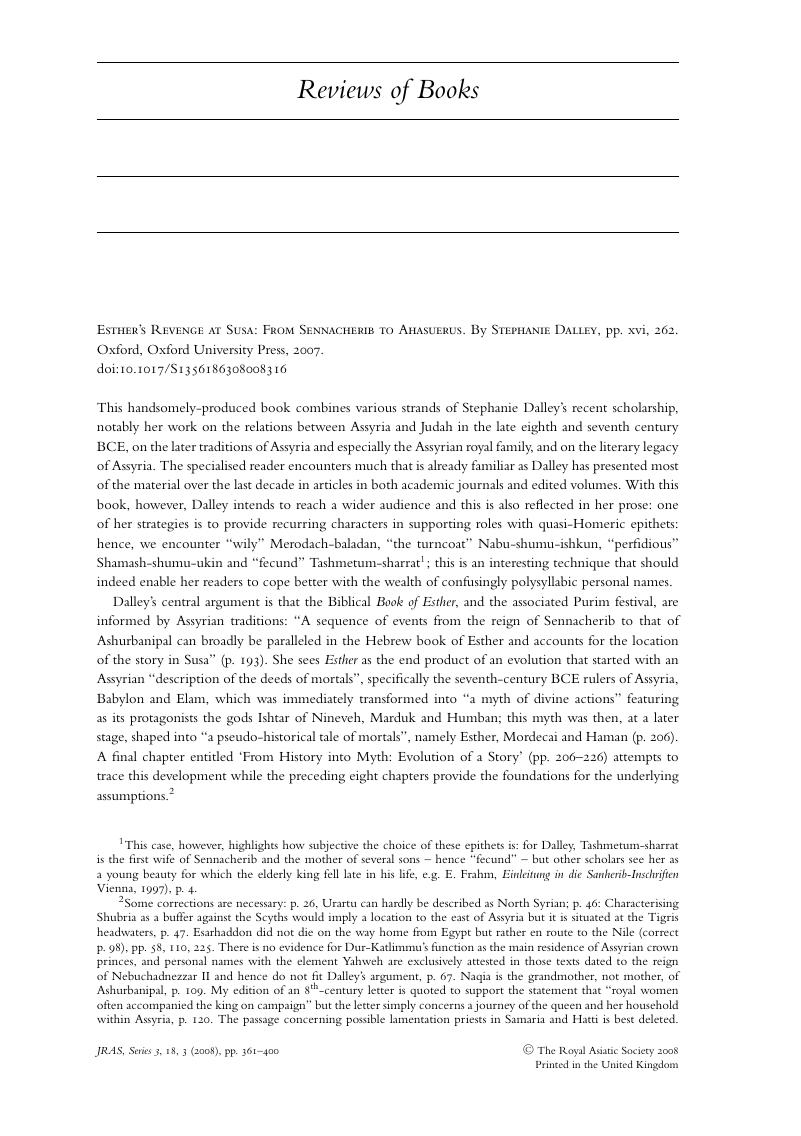No CrossRef data available.
Article contents
Esther's Revenge at Susa: From Sennacherib to Ahasuerus. By Stephanie Dalley, pp. xvi, 262. Oxford, Oxford University Press, 2007.
Published online by Cambridge University Press: 17 July 2008
Abstract

- Type
- Book Review
- Information
- Copyright
- Copyright © The Royal Asiatic Society 2008
References
1 This case, however, highlights how subjective the choice of these epithets is: for Dalley, Tashmetum-sharrat is the first wife of Sennacherib and the mother of several sons – hence “fecund” – but other scholars see her as a young beauty for which the elderly king fell late in his life, e.g. Frahm, E., Einleitung in die Sanherib-Inschriften Vienna, 1997), p. 4Google Scholar.
2 Some corrections are necessary: p. 26 Urartu can hardly be described as North Syrian; p. 46: Characterising Shubria as a buffer against the Scyths would imply a location to the east of Assyria but it is situated at the Tigris headwaters, p. 47. Esarhaddon did not die on the way home from Egypt but rather en route to the Nile (correct p. 98), pp. 58, 110, 225. There is no evidence for Dur-Katlimmu's function as the main residence of Assyrian crown princes, and personal names with the element Yahweh are exclusively attested in those texts dated to the reign of Nebuchadnezzar II and hence do not fit Dalley's argument, p. 67. Naqia is the grandmother, not mother, of Ashurbanipal, p. 109. My edition of an 8th century letter is quoted to support the statement that “royal women often accompanied the king on campaign” but the letter simply concerns a journey of the queen and her household within Assyria, p. 120. The passage concerning possible lamentation priests in Samaria and Hatti is best deleted. There is no doubt that the profession in question is the “Third Man” of a chariot team, p. 146. The Elamite ritual text stems from the mid to late second millennium, not the first millennium.
3 A rare instance in which an alternative interpretation is mentioned is on p. 25 fn. 40 where Reade, J.E., “Alexander the Great and the Hanging Gardens of Babylon”. Iraq 62 (2000), pp. 195–218CrossRefGoogle Scholar is said to be ‘a spoof’. Is it not.
4 See most recently Perdu, O., “Psammetique Ier, restaurateur de l'unité nationale et initiateur de renouveau saïte”. Egypte: Afrique et Orient 28 (2003), pp. 3–12Google Scholar.
5 The most recent discussion of this rather obscure profession is Stol, M., “Schauspieler und Flechter als Bedienstet.”, in Selz, G.J. (ed.), Festschrift für Burkhart Kienast (Münster 2003), p. 644 (courtesy F. van Koppen)Google Scholar.
6 Reade, J.E., “More about Adiabene”. Iraq 63 (2001) pp. 187–199CrossRefGoogle Scholar (in her bibliography but not quoted in the book). Walker, J.T., The legend of Mar Qardagh: Narrative and Christian heroism in late antique Iraq (Berkeley/Los Angeles/London, 2006)Google Scholar; id., “The Legacy of Mesopotamia in Late Antique Iraq: The Christian Martyr Shrine at Melqi (Neo-Assyrian Milqia)”. ARAM: Journal of Syro-Mesopotamian Studies 18–19 (2006–2007) pp. 471–496.
7 Chaumont, M. Z. in Encyclopaedia Iranica Vol. 1, fasc. 9 (London and Boston, 1986), p. 978Google Scholar.


